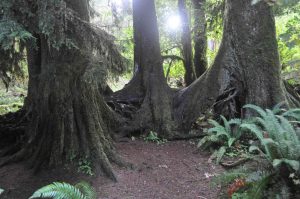By: Carol Pierson Holding
Last week on CBS News I watched a piece about Dutch farmer Marc van Rijsselberghe, who is running experiments in the Texel Islands, Netherlands, to grow potatoes using in salt-ridden land. As more and more salty water seeps through the Dutch dykes onto its farmland, van Rijsselberghe and others are finding ways to adapt.
When CBS asks van Rijsselberghe how he knows which test strain will work, he says, “We ask the plants.” Whether they live or die in salty soil dictates which strains will be sent to other places suffering salt-induced soil degradation.
It’s a huge piece of climate adaptation: The problem of salt-water intrusion affects 20 percent of the world's irrigated lands, up 37% since the early 1990s. Rising sea levels and reductions in usable water are driving this rapid increase. Once van Rijsselberghe identified strains of saltwater-loving potatoes, they were shipped to Pakistan where they are being successfully used in land formerly unusable for agriculture due to salt incursion.
I’ve heard more than a few people involved in the climate change movement despair that we’re too late. And maybe we are if we go at the problem thinking we have to solve it by ourselves. But what if we can tap into the intelligence of plants? Not just through binary experimentation — planting thirty varieties of potato to see which will grow in saltwater as van Rijsselberghe did — but to go further, even find new ways to absorb the excess carbon that’s leading to climate catastrophe?
We know that plants have their own intelligence. Ten years ago, Jeremy Narby codified scientific studies that prove so in Intelligence in Nature. Narby calls it “problem-solving at all levels of life” and describes the findings in a 2013 talk for Bioneers:
“Bees handle abstract concepts, slime molds solve mazes, and plants gauge the world around them. Science itself is evolving, moving away from a mechanical understanding of nature.”
We know that fungi clean up toxins and trees gobble carbon. German forester Peter Wohlleben goes even further. In his book The Hidden Life of Trees: What They Feel, How They Communicate, Wohlleben makes a compelling case for an arboreal social life that values the forest community over the individual tree. Tree roots feed each other, sacrificing their own growth to supplement the nutrition for a weaker member of their species, keeping alive young trees so that they can develop tougher trunks, which as they grow will in turn feed and shade older trees.
The biggest threat to the forest is not climate change but other species, notably humans:
“As climactic conditions change…A few old trees will die, but most of the rest of the forest will remain standing. If conditions become more extreme, one tree species could even be decimated without this being the end of the forest. The only proviso is that the social structure of the forest is not disturbed by lumber operations so that the forest can continue to regulate its own microclimate for itself.”
In other words, intra-species dependence is just as important as inter-species. Just as we depend on trees to produce oxygen, trees too depend on other life forms, especially fungi among which tree roots grow, exchange nutrients and share information about, for example, impending insect attacks.
The fact that The Hidden Life of Trees was a bestseller in Germany and is already #13 on the New York Times non-fiction bestseller list is a testament to its resonance with our own species. Human behavior also tends to be communal when it comes to climate change: residential solar panels are installed in waves, neighborhood by neighborhood. Even corporations act on climate change by industry grouping. Big box retail companies including Wal-mart, Costco and Ikea lead in installing solar panels on their enormous roofs; tech firms such as Amazon, Apple, Google and Microsoft have committed to renewable energy by building their own solar plants and lobbying – together - for the EPA’s Clean Power Plan.
Like trees, our species’ survival in the face of climate change is most successful when we put community over our individual selves. Imagine if we could also acknowledge what other living things have to teach us — we could expand our universe of potential partners to include all of nature. That’s a revolution in mindset, but oh the rewards.
Photo courtesy of Carol Pierson Holding.
 Carol Pierson Holding is President and Founder, Holding Associates. Carol serves as Guest Blogger for CSRHub. Her firm has focused on the intersection of brand and social responsibility, working with Cisco Systems, Wilmington Trust, Bankrate.com, the US EPA, Yale University’s School of Environmental Sciences, and various non-profits. Before founding Holding Associates, Carol worked in executive management positions at Siegel & Gale, McCann Erickson, and Citibank. She is a Board Member of AMREF (African Medical and Research Foundation). Carol received her AB from Smith College and her MBA from Harvard University.
Carol Pierson Holding is President and Founder, Holding Associates. Carol serves as Guest Blogger for CSRHub. Her firm has focused on the intersection of brand and social responsibility, working with Cisco Systems, Wilmington Trust, Bankrate.com, the US EPA, Yale University’s School of Environmental Sciences, and various non-profits. Before founding Holding Associates, Carol worked in executive management positions at Siegel & Gale, McCann Erickson, and Citibank. She is a Board Member of AMREF (African Medical and Research Foundation). Carol received her AB from Smith College and her MBA from Harvard University.
CSRHub provides access to corporate social responsibility and sustainability ratings and rankings information on 16,495+ companies from 135 industries in 133 countries. Managers, researchers and activists use CSRHub to benchmark company performance, learn how stakeholders evaluate company CSR practices and seek ways to change the world.
